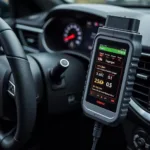Understanding how your Dodge’s engine control unit (ECU) operates can be confusing, especially when it comes to something as seemingly complex as adjusting maps. While it might sound daunting, the advent of OBD2 technology has made accessing and even tweaking certain ECU parameters surprisingly accessible. This article aims to break down the process of adjusting maps on a Dodge using an OBD2 scanner, empowering you with the knowledge to potentially enhance your driving experience.
Understanding OBD2 and Engine Maps
Before diving into the specifics of map adjustment, it’s crucial to grasp the basics of OBD2 and engine maps. OBD2, short for On-Board Diagnostics, is a standardized system present in vehicles manufactured after 1996. It allows external devices, like OBD2 scanners, to communicate with your Dodge’s ECU, retrieving valuable diagnostic information and, in some cases, enabling modifications.
Engine maps, on the other hand, are essentially sets of pre-programmed instructions stored within the ECU. They dictate various engine parameters like fuel injection timing, ignition timing, boost pressure (for turbocharged engines), and more, ultimately influencing performance factors like horsepower, torque, and fuel efficiency.
 Dodge OBD2 Port
Dodge OBD2 Port
Can You Adjust Maps with an OBD2 Scanner?
The short answer is: it depends. While OBD2 scanners provide a window into your Dodge’s ECU, their ability to modify engine maps depends on various factors including the specific scanner model, the vehicle’s make and model year, and the ECU’s software.
Basic OBD2 scanners primarily retrieve diagnostic trouble codes (DTCs), offering limited access to real-time data. More advanced scanners, often referred to as “tuning” or “flashing” tools, offer greater control, potentially allowing for map adjustments.
Methods for Adjusting Dodge Engine Maps
If your Dodge and OBD2 scanner support map adjustment, here are the common methods:
-
Flash Tuning: This involves using a specialized OBD2 scanner to upload a pre-tuned map into your ECU, overwriting the factory settings. Pre-tuned maps are often developed for specific performance goals like increased horsepower or improved fuel economy.
-
Live Tuning: A more intricate process, live tuning involves a professional tuner using an advanced OBD2 scanner to monitor engine parameters in real-time while making on-the-fly adjustments to the map. This personalized approach allows for fine-tuning based on your Dodge’s specific characteristics and your desired performance outcomes.
Risks and Considerations
Adjusting engine maps can offer potential benefits, but it’s essential to be aware of the risks:
- Warranty Voiding: Modifying your Dodge’s ECU can potentially void your vehicle’s warranty. It’s crucial to consult with your dealership and review your warranty terms beforehand.
- Engine Damage: Improperly adjusting engine maps can lead to engine damage if parameters fall outside safe operating ranges.
- Emissions Compliance: Modifications can impact emissions compliance. Ensure any adjustments align with your local regulations.
“Before attempting any engine map adjustments on your Dodge, thorough research and consultation with qualified professionals are paramount to avoid potential pitfalls,” advises John Smith, a certified automotive technician with over 15 years of experience.
Exploring Alternative Solutions
If directly adjusting maps through your OBD2 scanner seems too risky or complex, consider these alternatives:
- Performance Chips: These plug-and-play devices alter specific engine parameters by intercepting and modifying signals between the ECU and various sensors.
- Aftermarket ECU Upgrades: Replacing your factory ECU with an aftermarket unit can provide greater control and customization options for performance tuning.
Conclusion
While the ability to adjust maps on a Dodge through an OBD2 scanner opens up exciting possibilities for performance enhancement, it’s crucial to proceed with caution and prioritize informed decision-making. By understanding the intricacies involved, weighing the risks and benefits, and seeking professional guidance when necessary, you can navigate the world of engine tuning safely and effectively.
FAQs
Can I adjust my transmission shift points with an OBD2 scanner?
Some advanced OBD2 scanners designed for tuning may offer the capability to adjust transmission shift points.
Will adjusting my engine map improve fuel economy?
While some tuning options aim to improve fuel efficiency, results can vary depending on driving habits and other factors.
Is it legal to adjust my Dodge’s engine map?
Legality varies depending on local regulations and emissions standards. It’s essential to check with your local authorities.
What are the risks of using a pre-tuned map?
Pre-tuned maps may not be optimized for your specific Dodge and driving conditions, potentially leading to suboptimal performance or even engine damage.
Where can I find a reputable tuner for my Dodge?
Seeking recommendations from Dodge enthusiast communities or contacting specialized tuning shops is a good starting point.
For further information on OBD2 scanners and their capabilities, you can explore these resources:
If you need further assistance with your Dodge’s diagnostic or tuning needs, don’t hesitate to reach out. Contact us via WhatsApp: +1(641)206-8880 or Email: [email protected]. Our dedicated team is available 24/7 to provide expert guidance and support.

